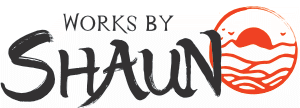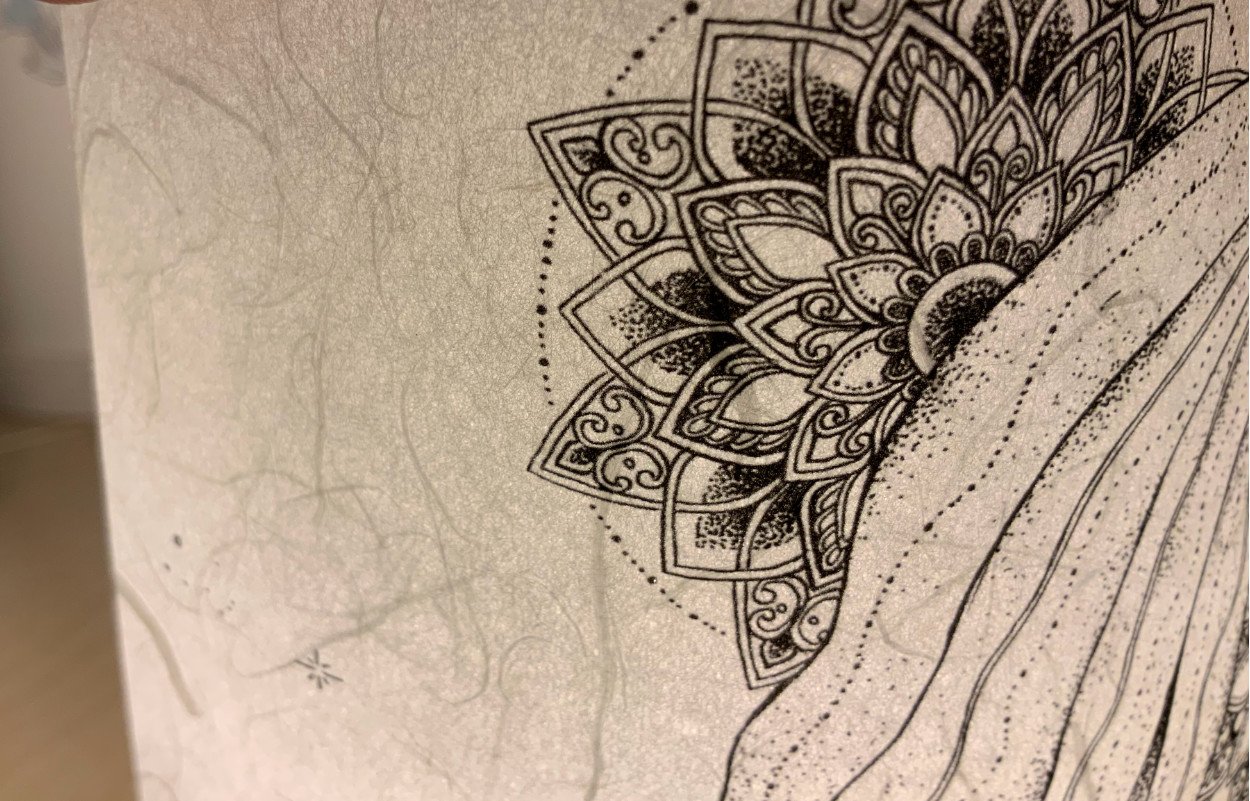Japanese paper (washi) selection and things to consider
Awagami Unryu paper. Artwork ©AquaMarynaStudio
There is so much more to learn and understand about suitable papers for lantern and lamp making, than first meets the eye. The more you explore, the more you realize this and eventually reach a point where you want to use Japanese washi paper for everything - that has been the case for me anyway. I will be coming back to this paper topic on an ongoing basis in future blog posts as my knowledge broadens, along with things I’ve tried and experimented with along the way.
I’m just beginning this “paper” journey. It has been challenging to find information on papers well suited for use on lanterns and lamps. This is likely because all the good stuff is not shared in English. So I have had to do a lot of experimenting, trial and error things - this is how it is likely to continue, for now. It’s been a very hands-on approach and I like that because there is a certain kind of knowing that comes from doing it this way, despite the amount of time it takes.
Japanese paper making is a 1400+ year tradition. With both handmade and machine made Japanese washi papers, great care and attention to detail is taken in the making of them, they are much sought after.
If you would like to learn more about the Japanese paper making process, here is a link to the wonderful Awagami “Family” who’s paper I also offer (3 inkjet papers). These papers are the most costly in my offerings, partly as a result of the high shipping costs. None-the-less, I find these papers wonderful to use and I love supporting all they stand for, along with helping, in some tiny way, “preserve the craft and pass washi papermaking onto the next generation”.
I am very fortunate to have a wonderful supplier for all the other kinds of Japanese papers I offer, along with Japanese decorative papers, right here in Canada - The Japanese Paper Place. I love supporting them for the same reasons I mentioned above. By making these papers available here in Canada, they truly help support the craft of washi papermaking. I reference them and their papers throughout the Artwork/Papers section of this website, be sure to explore the papers listed there and the incredible variety they have. They carry some unusual and colourful papers too, that come and go. I have a few of these and will share these in another post.
100% cotton paper (left) and Tanmo machine made Japanese paper (right)
As an entry level Japanese paper that cost just a few dollars extra vs the one cotton paper I offer, $3 or so, I highly recommend this next paper. This is a machine made Japanese washi paper, made on a special machine called a Tanmo machine. The paper from this machine looks and feels like handmade paper. This is my preference for the ‘Just Be and Bloom’ collection vs the cotton - it is thicker, holds ink better, has a wonderful mottled pattern and you know it’s a real Japanese made paper. This paper is also well suited for the ‘Be Gentle’ collection when used with, or without, printed artwork. This paper is pictured above on the right.
Alluded to above… I should mention the one cotton paper (100% cotton) I also offer, made in North America - it also offers archival qualities, so it will not degrade or yellow over time and is acid free. It is available for the ‘Just Be and Bloom’ collection, only as it’s simply not suited for use elsewhere. It is very thin and works well for that reason. The cotton paper has a different texture to the Japanese papers, it’s much more smooth, something difficult to take a photo of. It also illuminates with a distinct pattern, very different from both the handmade or machine made Japanese papers. This paper is pictured above on the left. You get to choose what goes on your lantern or lamp either way.
Ink holding contrast - cotton on the left, Japanese paper on the right.
Artwork ©AquaMarynaStudio
When it comes to choosing a paper, there are some things to consider, beyond the beauty aspects.
First is whether it has to be printed on. This limits the variety of papers available. I have around 5 to choose from currently - the one cotton option and 4 coated Japanese washi papers. Each has its own qualities/character - cost, colour, texture, thickness, pattern once illuminated and ink holding ability/contrast (important for illumination). I will guide you at the appropriate time if you feel overwhelmed.
I am still experimenting with Japanese papers that have no coating, but still provide a detailed, vivid (high contrast) image. My findings to date have shown that papers with this behavior need to be 100% Kozo, which makes them among the most expensive papers to use. However, they use traditional materials and are made without bleaching or brightening agents, which ensures the integrity of the paper fibers and with that longevity/archival strengths. I will share new findings in another post, I have a few papers lined up for testing.
If no printing is required, then there are a great many more papers to choose from - plain, patterned or hand silk screened. These paper selections are best suited to lanterns and lamps like the “Be Gentle” collection, if going the path of Chiyogami or Katazome-shi silk screened Japanese papers and plain papers for the ’Serenity Within’ collection. Your choice would be a personal one where you would make your selection based on cost, plain or silk screened, texture and pattern once illuminated. Again, be sure to checkout all the options in the “Artwork/Papers” section.
I will guide you each step of the way so you don’t need to worry about the finer details mentioned below - I’ve included them as you may find them interesting.
Second consideration when choosing a paper is a tricky one, something very challenging to show with photos - is related to how the paper diffuses or “modifies” light. It’s so interesting to see how this aspect can greatly impact the final result. The diffusion quality is closely linked to the texture of the paper, but it is also affected a great deal by the thickness or “weight” of the paper. The thinner the paper, usually, the less it diffuses or modifies the light, so you tend to see a more intense hot spot/bright spot, just where the bulb is.
Imagine looking at a light bulb through a sheet of washi - with a thin paper (light weight paper), you will see an intense bright center. Then as we move away from this “hot/bright” point, you will notice the light falls off very quickly, meaning that the paper seems less illuminated. This is the typical behavior of thin/light weight paper. You may be asking then, why use it? Good question! The thin paper allows more light to escape though the paper itself, so more of the environment is illuminated, which may be a desired effect. There is more to this too and I’ll explain below*. For now read on though…
How distance of the bulb to the paper affects light fall-off.
On the left 4” away, on the right 5” away.
With a thicker piece of paper, there will be a less intense bright spot and to our eye, the paper appears to be more evenly illuminated, so the fall-off of light is much more gradual, it feels and looks softer, we see a larger but less bright center. At the same time, less light is now able to escape and illuminate the environment. So this becomes the balance point. Since I only use a very low power LED light bulb, paper selection needs some added thought for the end result is you want. As all the lanterns and lamps I make are accent lights. I suggest going the path of a softer light and not to try to maximize the light that escapes. This provides a much softer and more desirable light source.
*Here is something else interesting to consider when choosing a paper… the distance the paper is away from the light bulb also affects how the light is diffused or modified, in a similar way to what the paper thickness or weight does. With a large lantern or lamp, like the large cubed shaped lamp from the “Be Gentle” collection, we actually need to choose a thinner paper if we do not want to loose too much light. Since the bulb is further away from the paper, the light diffuses/spreads more by the time it hits the paper, so we can get away with a thinner paper without any downsides. When the light bulb is close to the paper, we would ideally try to use a thicker paper or one that diffuses the light more, in order to get the nice soft light effect.
I hope you have a better understanding about selecting papers as well as a new appreciation for Japanese papers in particular, for their charm and character and how they modify light in such a gentle pleasing way, it is unmatched.
Please be sure to share any knowledge you may have along with other papers that may work well in this application, thank you.
A sampling of some delicate tissue papers that could work well when laminated onto thin washi to create a unique paper.
I have added some craft paper in behind so you can see the delicate patterns.





